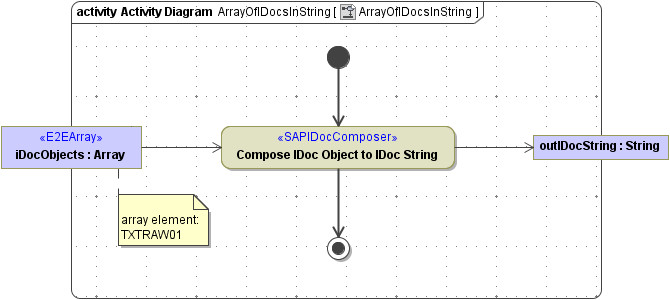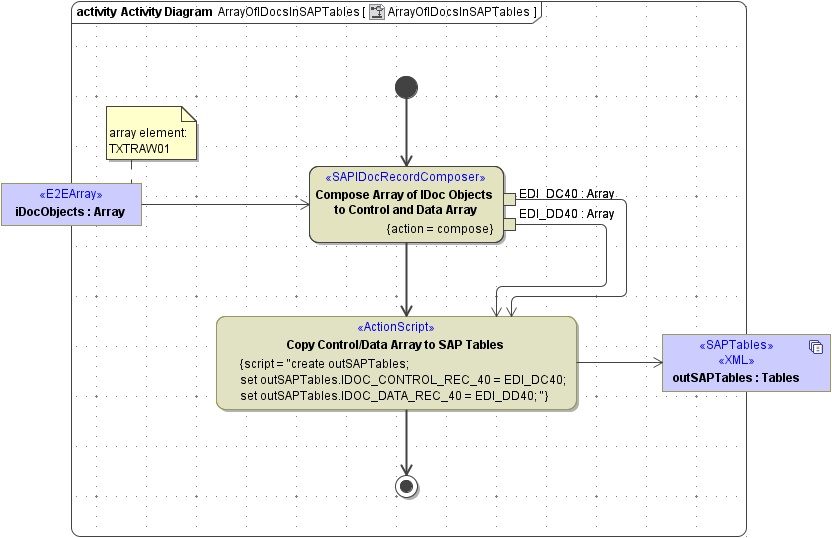IDocs (Interface Documents) are modeled as UML classes (cf. TXTRAW01). Such classes can be serialized into SAP IDoc tables (arrays) by the <<SAPIDocRecordComposer>>.
There are two situations in which you may want to compose an IDoc data buffer:
- You want to map an IDoc object (e.g. TXTRAW01, see figure below) to a String, keeping the structure of the data (mostly done, if you want to write the IDoc to a file).
This is done by an action having the stereotype <<SAPIDocComposer>> (see Composing to String). You want to map an IDoc object (e.g. TXTRAW01, see figure below) to a SAP tables structure (mostly done, if you want to perform an SAP RFC).
This is done by an action having the stereotype <<SAPIDocRecordComposer>> (see Composing to SAP Tables).After having composed an IDoc object, you can send it to an SAP backend using IDOC_INBOUND_ASYNCHRONOUS. The necessary interface is already part of the base components. Refer to tRFC Service for more information on how to implement the call.
Figure: UML Class Model of IDoc TXTRAW01
Composing to String: <<SAPIDocComposer>>
The <<SAPIDocComposer> takes one ore more IDoc objects as input and composes a String containing the object data. The structure of the data is kept (padding).
| Name | Type | Direction | Description | |
|---|---|---|---|---|
| anyObjectFlow | Any | in | Parsed IDoc object(s) The class specifying the type of this parameter must have stereotype <<SAPIDoc>>. | |
| idocString | String | out | String containing IDoc data (e.g. the content of an IDoc file) | |
The following examples are demonstrating some applications of the <<SAPIDocComposer>>.
Composing a Single IDoc to an IDoc String
Figure: SAPIDocParser, Single IDoc to a String
Composing Multiple IDocs to an IDoc String
Figure: SAPIDocComposer, Multiple IDocs to a String
Composing to SAP Tables: <<SAPIDocRecordComposer>>
The <<SAPIDocRecordComposer> takes one ore more IDoc objects as input and composes an array of structured control records and an array of structured data records (as expected for SAP tables).
| Name | Type | Direction | Description | |
|---|---|---|---|---|
| anyObjectFlow | Any | in | Parsed IDoc object(s) The class specifying the type of this parameter must have stereotype <<SAPIDoc>>. | |
| EDI_DC40 | Array | out | Array of IDoc structured control records | |
| EDI_DD40 | Array | out | Array of IDoc structured data records | |
Composing a Single IDoc to SAP Tables
Figure: IDoc Composer with a IDoc-array to Tables
Composing Multiple IDocs to SAP Tables
Figure: IDoc Composer with a IDoc-array to string
Composing to XML: <<SAPXMLIDocComposer>>
The <<SAPXMLIDocComposer> takes one ore more IDoc objects as input and composes a Blob containing the object data. The structure of the data is kept (padding).
| Name | Type | Direction | Description | |
|---|---|---|---|---|
| anyObjectFlow | Any | in | Parsed IDoc object(s) | |
| idocBlob | Blob | out | Blob containing IDoc data (e.g. the content of an IDoc file) | |
The following example is demonstrating an application of the <<SAPXMLIDocComposer>>.
Composing Multiple IDocs to an XML Blob
Figure: SAPIDocParser, Multiple IDocs to XML
IDoc Composition and SAP R/3
The above examples show how to compose IDocs version of 4.x. However, SAP R/3 3.x systems use IDocs, too. These IDocs are handled similar as in version 4.x. The differences between composing version 4 and version 3 IDocs are as follows :
- IDoc3 Composer Stereotype: <<SAPIDoc3Composer>>
- IDoc3 Stereotype: <<SAPIDoc3>>, this is taken into account if the import was done in version 3 mode (see Importing SAP IDoc Meta Data).





